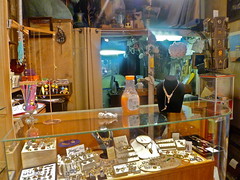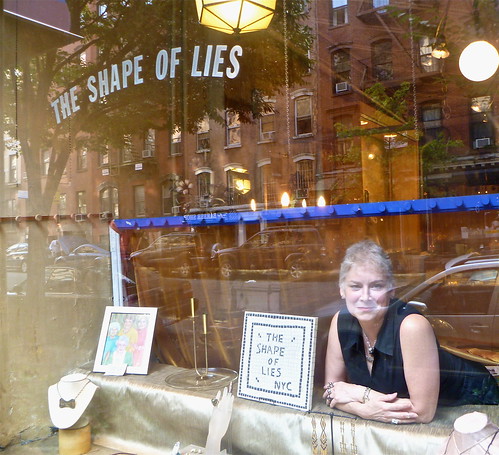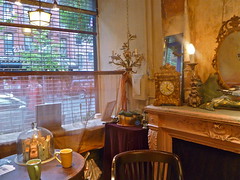For every East Village business that’s opening or closing, dozens are quietly making it. Here’s one of them: Shape of Lies.
Collage artist and jewelry designer Peggy Yunque has been living and working at 127 East Seventh Street with her husband, a sculptor and filmmaker, for almost 33 years. That means when customers walk into her shop, Shape of Lies, during its fairly limited hours (Thursday and Friday, 3 p.m. to 8 p.m., and Saturday and Sunday, noon to 8 p.m.) they’re standing in her living room. That card table tucked behind a display case? It’s actually their dinner table.
“People in the neighborhood know we live there, so if they have a gift emergency and the gate is down, or the lights are off, they knock,” Ms. Yunque told The Local. “I think we might be one of the only stores in the neighborhood living where we work. It’s sad how much things like that have changed in the city.” Ms. Yunque pulled out the table, some grapefruit juice from the fridge, and we sat by her fireplace surrounded by a dozen collections of locally made accessories and talked about how she ended up “breaking even since 1979.”
What exactly is The Shape of Lies?
We are a studio, a workshop and a shop. We only carry designers who produce their products in New York. That’s different from just carrying local designers. Many local designers produce their work in China or Thailand. We don’t do that. We use only the casters, sauterers, and finishers on 47th Street because we have so few of them left.
How does one get to be a designer in your store?
You come and show me your stuff and if I like it, you’re in. I don’t care where you live. If you live in Wisconsin, Chicago, France but come here to do casting, then we’re good. All I am interested in is that the production is done here in New York. Imagination is everywhere. Creativity is in any city. Production is not in every city and it’s harder and harder to do it.
You must get a lot of people coming in to show you’re their work.
We don’t show 120 designers. I never carry more than twelve designers at once because you have to have a certain amount of space to properly show what their work does.
What are your prices like in the store?
Very reasonable. They range $38 to $86 mostly and then some pieces are roughly $300. The holster and gun piece is our most expensive and is $1,400. We price things fairly. You aren’t going to find something little and simple for $300 just because.
You’re not in it to make money, it seems.
I am not an entrepreneur or business owner by definition. We are a cottage-industry mom-and-pop. We’re a micro business. We make things and sell them from inside our cottage. We only support ourselves. I don’t have employees. I am everything in the store.
How do you afford to live and work here with such limited hours as rent prices go up?
I don’t talk about the rent. It’s like weather. You only talk about it when it’s good. I will say this: We got hammered in the ’80s, absolutely hammered with high rent. That is what forced us to go into business. We were backed into running a business in order to keep the store. I learned how to bob and weave. We were able to survive because we did a lot of wholesale to keep us afloat. We’ve done wholesale on and off for years. Actually, I am planning to again. This time, I will bring a few of my designers with collections that are ready for that.
Would you say in some ways you are evolving out of the cottage business mentality whether by choice or not?
We’ve always been slow at evolving but still evolving. We were wholesale for 17 years and I was doing my own stuff. When we first were open it was just on the weekends and Christmas. We had to take our time. Most stores are done in five years.
 Shira Levine Display counter.
Shira Levine Display counter.
Is there a time when business was really good for you?
The ’80s actually was a heyday for us. It was all about consumption and Wall Street. People were throwing money at artists like crazy. It was the perfect storm. People would walk up and make excuses to buy something. They’d go: “I really shouldn’t, but it’s the color of my daughters eyes! I’m going to buy three of them!”
How is business now for you?
It’s the opposite now. Instead they are telling themselves reasons not to buy. When times are good we can be really brave with the outrageous pieces because people were willing to spend. When a crash happens people want small things and gold because they can rely on it. There also becomes a demand for less quality.
What advice do you have to people trying to make it on their own like you?
You need an IRA and to put the maximum away right away when you’re a business like this. When you get a profit from something, you put 1/3 into your fund you don’t touch, then 1/3 goes to whatever you need for your business, and then 1/3 goes back into the work you want to do. You can’t put 100 percent back into your work. So many people do that. You need to be strategic and I show my designers this and help them so they can make a living.





